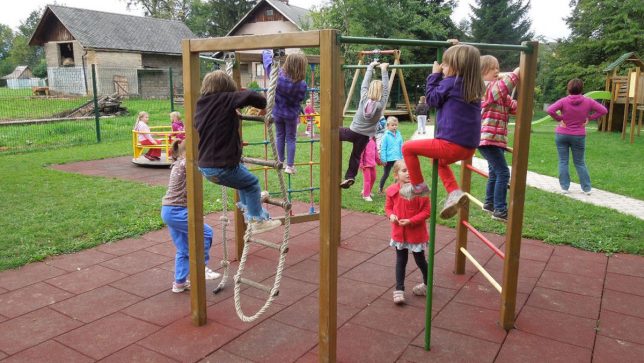Fruit and wine production is among the agricultural sectors with the highest pesticide applications. Yet, the extent to which such public places are affected by pesticide drift from agricultural fields is largely unknown. In the first study of its kind, 71 public playgrounds in South Tyrol (Italy) were tested for pesticide contamination.

Nearly half of the investigated playgrounds were found to be contaminated with pesticides. In total, 12 pesticides were found. The findings are especially worrisome as 92% of the detected pesticides are considered to be ‘hormone-active’ (part of the family of chemicals with endocrine disrupting properties). The study also showed that pesticide contamination was dependent on the distance from, and the proportion of, agricultural fields in the surrounding landscape, as well as from wind and rainfall. These findings have been published in the journal Environmental Sciences Europe (Linhart et al. 2019).
Pesticides which are applied on agricultural fields to fight pestiferous insects, weeds or pathogenic fungi can easily be volatized, drift away with winds or washed away by rain. While agricultural products are regularly monitored for possible pesticides residues, no monitoring is established for public areas or private gardens.
Investigations on playgrounds in four agricultural regions
“In the province of South Tyrol, one of the most intensive apple-producing regions in Europe, pesticide drift is a very contentious topic of discussion. With this study, we wanted to provide scientific data to this debate,” explains Koen Hertoge, study leader of the Pesticide Action Network Europe, a non-governmental organisation based in Brussels. Concretely, 71 public playgrounds in the four South Tyrolean regions (Venosta valley, Adige valley, Low Adige, Isarco valley) were randomly selected and grass samples were analysed for potential contamination by 315 pesticides.
“The unique aspect of our study was not only the determination of pesticide residues, but also the analysis of underlying factors. Hence, we wanted to find out whether the distance from the next apple orchard or vineyard, wind direction and speed, or solar irradiance, has an influence on potential pesticide contamination,” specifies the first author of the study, Caroline Linhart.
Nearly all detected pesticides considered hormone-active
In total, we found 12 different pesticides in the playgrounds. Playgrounds in the Venosta valley were most often contaminated, those in Low Adige had the highest pesticide concentrations. “I can imagine that people reading our study will respond that it is not relevant if grass samples are contaminated with pesticides because children do not eat grass,” comments Peter Clausing, coauthor and toxicologist of the Pesticide Action Network Germany in Hamburg.
“However, the discovery that 92% pesticides found are considered to be endocrine-active substances should worry us. These substances can alter early development, which is an especially sensitive phase for children. Exposure to such endocrine disruptors can have long-term detrimental effects, and could possibly cause cancer, impaired brain functions, obesity and diabetes,” explains Clausing.
Assessments of pesticide drift need to become more realistic
Our analyses also showed that the measured pesticide concentrations were higher in playgrounds located closer to the orchards. Furthermore, weather conditions such as rainfall and stronger winds were also related to higher pesticide concentrations, as explained by Linhart.
The study authors used a risk model including weather conditions and other environmental factors to predict possible pesticide concentrations. „Of course a prediction model always features a range of uncertainty, but the model could considerably contribute to a better pesticide application model, as well as to decrease pesticide drift.
The results of the study also show that the distance between playgrounds and agricultural areas should be of at least 100m, in order to avoid pesticide contamination as much as possible. However, through stronger wind conditions pesticides could drift over 300m away and possibly even further; moreover, higher residue concentrations are more likely depending on radiation conditions.
“These climatic aspects are usually ignored when assessing the environmental impact of pesticides,” says Hertoge. His conclusion from this study is that measures currently in place to mitigate pesticide drift are obviously not sufficient, and calls for a comprehensive pesticide monitoring system in public places embedded in agricultural areas with intensive pesticide use. “The EU directive on the Sustainable Use of Pesticides (1107/2009) is up for revision soon (by 2019, but it could be postponed depending on Member States‘ implementation of National Action Plans). We call on this revision for pesticides to finally be banned, rather than ‘seriously limited’, in public areas,” Hertoge concludes.




















